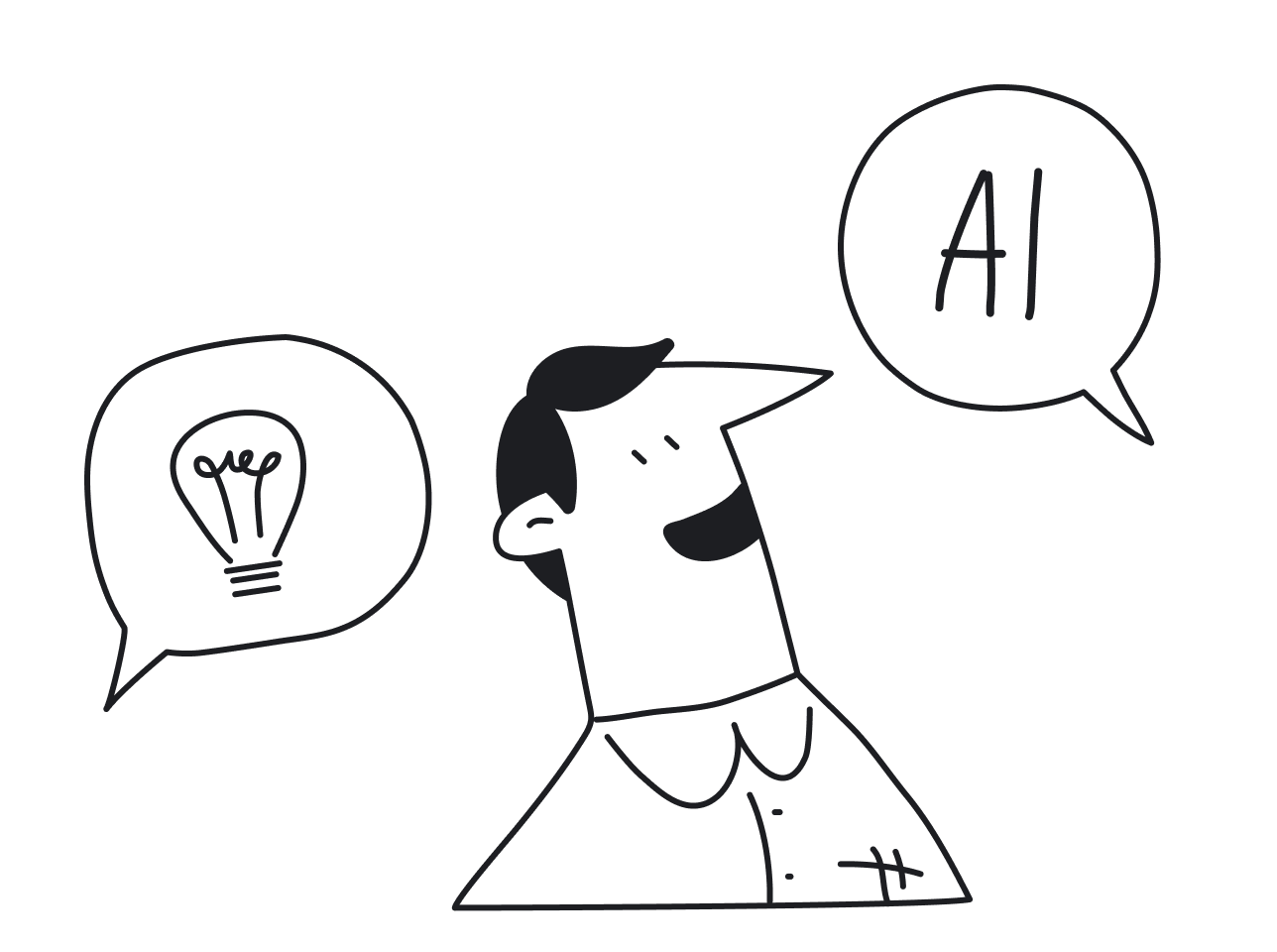Gone are the days when artificial intelligence (AI) was only accessible to large corporations with significant computing resources and budgets, like Google or Microsoft. With AI models like GPT, businesses of all sizes can now leverage its power. So, artificial intelligence is now at the forefront of any innovation in every industry we can think of. And as a team of product designers, at Eleken we believe that this new AI everywhere era has paved the way for innovations in user experience as well.
Today, we will explore how AI UX can make your product more intuitive, enhancing the overall user experience, and this way helping you compete with larger companies. And real-world examples of businesses that have successfully integrated AI into their products’ interfaces will help us with this goal.
Ways in which AI can enhance UI
UI/UX designers aim to create intuitive and enjoyable interfaces by understanding user behavior, preferences, and needs. And recently, AI (and particularly chatGPT) has emerged as a powerful tool to help cope with this challenge, unlocking a whole new level of design potential.
It has become one of the most prominent SaaS trends: cloud companies use artificial intelligence to create more intuitive and efficient designs, improving the user experience. So, let’s discover the ways in which AI can make UI better and take a look at AI-powered SaaS companies that are already taking advantage of this technology to improve their products’ overall user experience.
1. AI helps businesses personalize the user experience
Personalization improves user experience by tailoring features and content to the specific interests, needs, or issues of individual users. For example, you can leverage AI to detect usage patterns and behaviors from their order history, wish lists, or viewed items. With this information, AI algorithms can create personalized recommendations, content, or marketing messages that are adjusted to the individual user. This way, you can guarantee that you provide the optimal UX, increase engagement and stay ahead of your rivals.
On March 9, 2023, Grammarly announced GrammarlyGO— an on-demand, contextually aware assistant powered by generative AI. This tool provides contextually relevant suggestions, taking into account users’ personal voice and brand style, while also adhering to the augmented intelligence philosophy that prioritizes customer control.
Grammarly stresses that the unique value proposition of GrammarlyGO lies in its ability to offer a personalized experience that produces text tailored to each customer's needs. And of course, they reach such a high level of personalization with a generative AI approach.

2. AI makes chatbots more human-like
Chatbots present a promising solution for those seeking to enhance the customer experience and reach new audiences. AI-powered chatbots are able to improve user experience and learn on the go thanks to machine learning (ML) and natural language processing (NLP), in particular. ML algorithms allow chatbots to improve the accuracy of their responses when faced with unfamiliar inputs. The result is more human-like interactions with the chatbots, and enhanced overall user experience.
For example, Duolingo has recently turned to OpenAI’s GPT-4 to fill such gaps in learners’ journeys as conversation practice and contextual feedback on mistakes.
With GPT-4, Duolingo launched Role Play, an AI conversation partner that is able to give users accurate responses so that they feel like talking with a native speaker. This way the app provides a more effective and engaging learning experience, which in its turn leads to pleasant user experience.

3. AI can assist in automating certain tasks
Integrating AI in UX design to automate tasks can help reduce the cognitive load on users by minimizing the need for voice commands, gestures, or buttons, thereby improving the user experience. Automating tasks with the help of artificial intelligence can enhance the product’s UX in several ways:
- The use of chatbots. They can enhance the user experience by providing automatic and intuitive responses to user requests. Chatbots powered by AI models like GPT can provide personalized assistance and quickly resolve customer issues.
For instance, Stripe provides developers with extensive technical documentation and a robust support team to answer technical questions and troubleshoot issues. However, this process can be time-consuming. To speed it up and automate the process, Stripe has turned to GPT-4 which functions as a virtual assistant, digesting and understanding the user's question, reading detailed documentation on their behalf, identifying the relevant section, and summarizing the solution in one place.

- The automation of repetitive or mundane tasks, such as data entry, content tagging, and the like. Notion's "Smart Links" feature automatically generates previews of external content and provides context for links shared within the platform. Isn’t it time-saving?

4. AI simplifies search and navigation for users
Making search and navigation more efficient and user-friendly leads to a more enjoyable user experience. AI can analyze the user's interactions with the application and provide personalized recommendations for content or products. AI can also help with navigation by providing suggestions for related content or products, and by creating intuitive interfaces that adapt to the user's behavior and preferences.
As an example, we can mention Notion here with its ability to recognize and categorize different types of content and suggest relevant tags and categories based on the content, which can help users organize and search for information more easily. When you start typing a tag in a database field or inline in a page, Notion will suggest tags based on the content of your notes.

5. AI models can help businesses analyze and interpret large amounts of user data, providing valuable insights into user behavior and preferences
AI models can be trained to identify patterns, trends, and anomalies within data sets, and can also be used to extract insights and actionable information from unstructured data sources like social media posts, customer reviews, support tickets, and so on. By analyzing this data, businesses can gain a better understanding of customer preferences, behavior, and needs, which can inform decisions around improving UX.
A great example here is again Stripe. Incorporating GPT-4 helped them better understand their users’ businesses. In order to provide the most suitable client support, Stripe aims to understand how each business uses the platform and address their issues accordingly. However, this process can be time-consuming and requires a significant amount of human effort.
What's more, some businesses tend to have sparse and enigmatic websites, making it complicated to grasp their operations through searching and clicking. To address this issue, Stripe uses GPT-4 technology to scan these websites and produce a summary that surpasses human-written ones. This way, with the help of OpenAI’s GPT-4, Stripe can gain a better understanding of their users’ businesses and streamline their user experience.
There are much more than five benefits AI can give your product, but as you can see UX and artificial intelligence can go well together, helping businesses better serve their clients. So, I guess it would be good for you to learn some ways to integrate AI into your business.
How GPT technologies can be integrated into the product
As you can see, many successful businesses think of AI in UX design not just like using ChatGPT by an individual designer in their team, they actually make this technology a part of the company’s UX strategy and incorporate AI features straight into their products. After all, with the ability to analyze user data, identify patterns, and adapt to individual user needs, GPT-based AI features can be really helpful in optimizing the interface and improving user experience.
So, let’s summarize the information we’ve learned today. Here are four effective methods to use GPT-powered by technologies in your UX strategy.
- Implement a chatbot to assist users with navigation.
Chatbots can provide 24/7 support to users, reducing the workload for customer service representatives. This way, when powered by GPT technologies, bots can serve as a smart catalog, suggesting users relevant content or features. It helps the user browse through content and reduces the time they spend searching for what they need. Chatbots can also guide users through specific tasks or workflows by providing step-by-step instructions or answering any questions they may have.
- Add a virtual assistant to provide personalized recommendations.
GPT models are valuable in creating personalized recommendations, based on the user's actions, preferences, or other use cases. You can train the bot to provide a personalized experience using the website data, like order/search/browse history, and so on.
- Use a bot to help with the user experience analysis.
There are various ways in which you can use the GPT model in UX research:
- Engage with customers and gather information about their needs. A chatbot can gather feedback from users about the way they interact with your product (features they use most often, features that they would like to see in your product, and so on), analyze the responses, and suggest potential improvements for enhancing the user interface.
- Analyze user feedback and generate reports. GPT-based bot can analyze customer reviews on different platforms, categorize feedback by sentiment and topic, and identify common issues and complaints. This information can be used to improve the user experience by identifying areas that need improvement and developing solutions to address those issues.
- Use GPT technologies to automate the process of categorizing and prioritizing support tickets.
GPT-based models can analyze the content of support tickets to determine the urgency and complexity of the issue, and automatically assign them to the appropriate support agent or team. This way, you won't miss UX issues and will be able to address the most critical of them in time.
What's next?
Numerous examples of AI in SaaS products today indicate that artificial intelligence is here to stay and will likely change the way many industries work and function now. So it’s natural that so many companies are trying to keep up with the integration of AI into their products. And as advancements in AI technology continue, we can expect even more powerful tools to become available in the near future.
All these facts lead us to the thought that today is a perfect opportunity for businesses to explore and leverage AI technologies to enhance their SaaS products and stay ahead of the competition.
However, to see the full potential of AI in improving your product’s UI, it's essential to approach the integration process strategically and thoughtfully. It's crucial to have a clear understanding of how to design the GPT-driven conversational UI so that it helps you reach your goals. To achieve this, you may need a design expert on your team with experience in creating UX design for AI products.
Eleken designers have the necessary expertise. Our cases like Stradigi AI, Astraea, and Cylynx taught us what UI/UX design principles work best when creating UX for machine learning and AI software. So, if you need help from professional designers, don’t hesitate to contact us.













